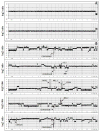Genome-wide comparison of paired fresh frozen and formalin-fixed paraffin-embedded gliomas by custom BAC and oligonucleotide array comparative genomic hybridization: facilitating analysis of archival gliomas
- PMID: 21080181
- PMCID: PMC3059338
- DOI: 10.1007/s00401-010-0773-z
Genome-wide comparison of paired fresh frozen and formalin-fixed paraffin-embedded gliomas by custom BAC and oligonucleotide array comparative genomic hybridization: facilitating analysis of archival gliomas
Abstract
Array comparative genomic hybridization (aCGH) is a powerful tool for detecting DNA copy number alterations (CNA). Because diffuse malignant gliomas are often sampled by small biopsies, formalin-fixed paraffin-embedded (FFPE) blocks are often the only tissue available for genetic analysis; FFPE tissues are also needed to study the intratumoral heterogeneity that characterizes these neoplasms. In this paper, we present a combination of evaluations and technical advances that provide strong support for the ready use of oligonucleotide aCGH on FFPE diffuse gliomas. We first compared aCGH using bacterial artificial chromosome (BAC) arrays in 45 paired frozen and FFPE gliomas, and demonstrate a high concordance rate between FFPE and frozen DNA in an individual clone-level analysis of sensitivity and specificity, assuring that under certain array conditions, frozen and FFPE DNA can perform nearly identically. However, because oligonucleotide arrays offer advantages to BAC arrays in genomic coverage and practical availability, we next developed a method of labeling DNA from FFPE tissue that allows efficient hybridization to oligonucleotide arrays. To demonstrate utility in FFPE tissues, we applied this approach to biphasic anaplastic oligoastrocytomas and demonstrate CNA differences between DNA obtained from the two components. Therefore, BAC and oligonucleotide aCGH can be sensitive and specific tools for detecting CNAs in FFPE DNA, and novel labeling techniques enable the routine use of oligonucleotide arrays for FFPE DNA. In combination, these advances should facilitate genome-wide analysis of rare, small and/or histologically heterogeneous gliomas from FFPE tissues.
Figures






Similar articles
-
Glioma test array for use with formalin-fixed, paraffin-embedded tissue: array comparative genomic hybridization correlates with loss of heterozygosity and fluorescence in situ hybridization.J Mol Diagn. 2006 May;8(2):268-76. doi: 10.2353/jmoldx.2006.050109. J Mol Diagn. 2006. PMID: 16645215 Free PMC article.
-
Bacterial artificial chromosome array-based comparative genomic hybridization using paired formalin-fixed, paraffin-embedded and fresh frozen tissue specimens in multiple myeloma.Cancer. 2009 Jan 15;115(2):345-54. doi: 10.1002/cncr.24021. Cancer. 2009. PMID: 19109814
-
Application of array CGH on archival formalin-fixed paraffin-embedded tissues including small numbers of microdissected cells.Lab Invest. 2006 Sep;86(9):968-78. doi: 10.1038/labinvest.3700441. Epub 2006 Jun 5. Lab Invest. 2006. PMID: 16751780 Free PMC article.
-
Accuracy of Molecular Data Generated with FFPE Biospecimens: Lessons from the Literature.Cancer Res. 2015 Apr 15;75(8):1541-7. doi: 10.1158/0008-5472.CAN-14-2378. Epub 2015 Apr 2. Cancer Res. 2015. PMID: 25836717 Free PMC article. Review.
-
Formalin fixation in the '-omics' era: a primer for the surgeon-scientist.ANZ J Surg. 2012 Jun;82(6):395-402. doi: 10.1111/j.1445-2197.2012.06092.x. Epub 2012 May 9. ANZ J Surg. 2012. PMID: 22571596 Review.
Cited by
-
Diagnostic test accuracy and cost-effectiveness of tests for codeletion of chromosomal arms 1p and 19q in people with glioma.Cochrane Database Syst Rev. 2022 Mar 2;3(3):CD013387. doi: 10.1002/14651858.CD013387.pub2. Cochrane Database Syst Rev. 2022. PMID: 35233774 Free PMC article.
-
Molecular pathologic diagnosis of epidermal growth factor receptor.Neuro Oncol. 2014 Oct;16 Suppl 8(Suppl 8):viii1-6. doi: 10.1093/neuonc/nou294. Neuro Oncol. 2014. PMID: 25342599 Free PMC article. Review.
-
Genomic changes in gliomas detected using single nucleotide polymorphism array in formalin-fixed, paraffin-embedded tissue: superior results compared with microsatellite analysis.J Mol Diagn. 2011 Sep;13(5):541-8. doi: 10.1016/j.jmoldx.2011.05.009. Epub 2011 Jul 2. J Mol Diagn. 2011. PMID: 21726663 Free PMC article.
-
Comparison of whole genome amplification methods for analysis of DNA extracted from microdissected early breast lesions in formalin-fixed paraffin-embedded tissue.ISRN Oncol. 2012;2012:710692. doi: 10.5402/2012/710692. Epub 2012 Mar 14. ISRN Oncol. 2012. PMID: 22530150 Free PMC article.
-
Microfoci of malignant progression in diffuse low-grade gliomas: towards the creation of an intermediate grade in glioma classification?Virchows Arch. 2015 Apr;466(4):433-44. doi: 10.1007/s00428-014-1712-5. Epub 2015 Jan 21. Virchows Arch. 2015. PMID: 25861023
References
-
- Bejjani BA, Shaffer LG. Clinical utility of contemporary molecular cytogenetics. Annu Rev Genomics Hum Genet. 2008;9:71–86. - PubMed
-
- Bussey KJ, Chin K, Lababidi S, Reimers M, Reinhold WC, Kuo WL, Gwadry F, Ajay, Kouros-Mehr H, Fridlyand J, Jain A, Collins C, Nishizuka S, Tonon G, Roschke A, Gehlhaus K, Kirsch I, Scudiero DA, Gray JW, Weinstein JN. Integrating data on DNA copy number with gene expression levels and drug sensitivities in the NCI-60 cell line panel. Mol Cancer Ther. 2006;5:853–867. - PMC - PubMed
-
- Cai WW. Detection of DNA copy-number alterations in complex genomes using array comparative genomic hybridization. Methods Mol Biol. 2007;381:105–119. - PubMed
Publication types
MeSH terms
Substances
Grants and funding
LinkOut - more resources
Full Text Sources
Other Literature Sources

